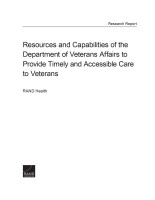| 来源类型 | Research Reports
|
| 规范类型 | 报告
|
| DOI | https://doi.org/10.7249/RR1165.2
|
| ISBN | 9780833092151
|
| 来源ID | RR-1165/2-VA
|
| Resources and Capabilities of the Department of Veterans Affairs to Provide Timely and Accessible Care to Veterans |
| Peter S. Hussey; Jeanne S. Ringel; Sangeeta C. Ahluwalia; Rebecca Anhang Price; Christine Buttorff; Thomas W. Concannon; Susan L. Lovejoy; Grant R. Martsolf; Robert S. Rudin; Dana Schultz; et al.
|
| 发表日期 | 2015
|
| 出版年 | 2015
|
| 页码 | 409
|
| 语种 | 英语
|
| 结论 |
VA Faces Challenges in Planning for and Using Its Resources Effectively- VA is one of the largest health providers in the world, but its workforce and facility capacity may not be sufficient to provide timely care to veterans across a number of key specialties, as well as primary care.
- Purchased care offers one solution to these limitations, but VA faces challenges in managing this option.
- Accelerated hiring and productivity increases, aided by technology, will be necessary if VA is to meet an anticipated increase in demand for care over the next five years.
Some Veterans Face Barriers to Accessing VA Health Care in a Timely Manner- The vast majority of veterans live within 40 miles of VA care but actual geographic access varies according to the access standard used and by region and type of service.
- According to VA standards, most veterans do not face long waits for care, but there is considerable variation in timeliness across facilities. VA patients report that they are less likely than private-sector patients to get appointments as soon as needed.
- VA's timeliness standard is much less demanding than the standards used in the private sector.
The Quality of VA Care Is Good Overall, but Performance Varies Across Facilities- VA outpatient care outperformed non-VA outpatient care on almost all quality measures. VA hospitals performed the same or better than non-VA hospitals on most inpatient quality measures, but worse on others.
- Although most VA facilities maintain high levels of quality, there is variation across facilities, with best practices not universally identified or adopted.
|
| 摘要 |
- VA should take significant steps to improve access to care. It should use a systematic, continuous performance improvement process to reduce variability in access to care and evaluate options for increasing its capacity, including hiring additional providers, granting advanced practice nurses full practice authority, and increasing the use of virtual care.
- VA should systematically identify opportunities to improve access through the use of purchased care. It should streamline programs for purchasing care and use them strategically to minimize cost.
- VA should reexamine its standards for timely access to care and consider alternatives. Specifically, it should examine the utility of existing benchmarks, such as same-day availability of appointments, used in other health care systems.
- VA and Congress should develop and implement more sensitive standards for geographic access to care. Better data collection and analysis would help VA determine where veterans are facing geographic access barriers and where purchased care could fill access gaps.
- VA should establish itself as a leader and innovator in health care redesign. VA has historically been on the forefront of health care innovations, and being a large, integrated delivery system positions it to continue to do so.
|
| 主题 | Health Care Access
; Health Care Facilities
; Health Care Quality
; Health Care Services Capacity
; Health Care Workforce
|
| URL | https://www.rand.org/pubs/research_reports/RR1165z2.html
|
| 来源智库 | RAND Corporation (United States)
|
| 引用统计 |
|
| 资源类型 | 智库出版物
|
| 条目标识符 | http://119.78.100.153/handle/2XGU8XDN/108002
|
推荐引用方式
GB/T 7714 |
Peter S. Hussey,Jeanne S. Ringel,Sangeeta C. Ahluwalia,et al. Resources and Capabilities of the Department of Veterans Affairs to Provide Timely and Accessible Care to Veterans. 2015.
|
|
文件名:
|
x1495316234679.jpg
|
|
格式:
|
JPEG
|

|
文件名:
|
RAND_RR1165z2.pdf
|
|
格式:
|
Adobe PDF
|
除非特别说明,本系统中所有内容都受版权保护,并保留所有权利。